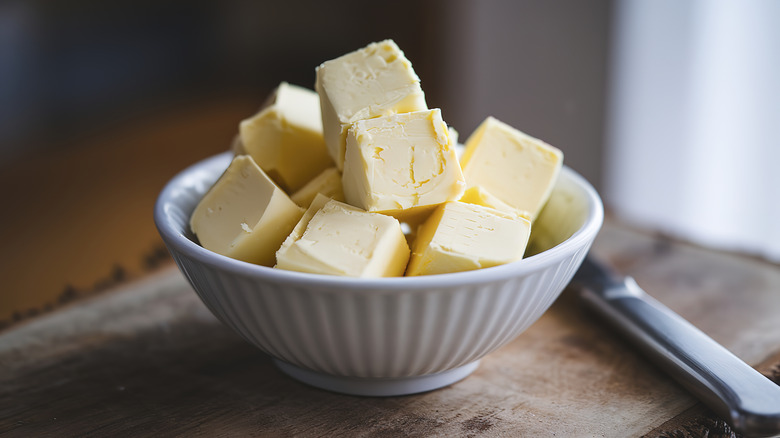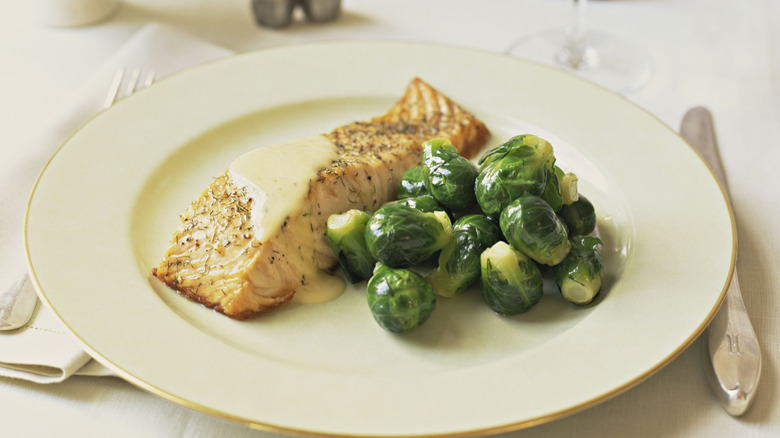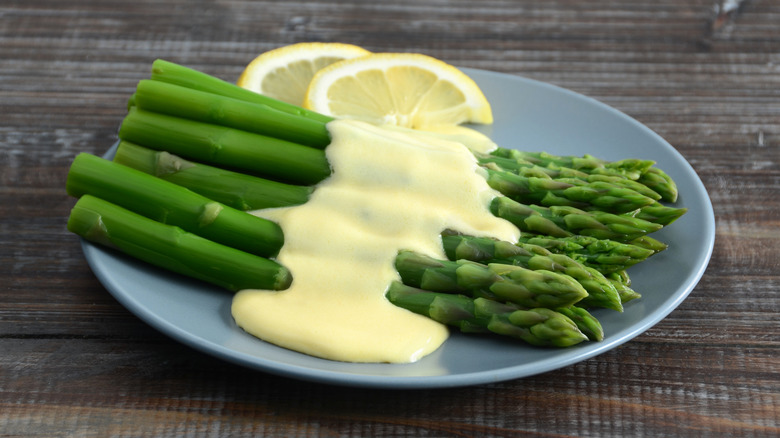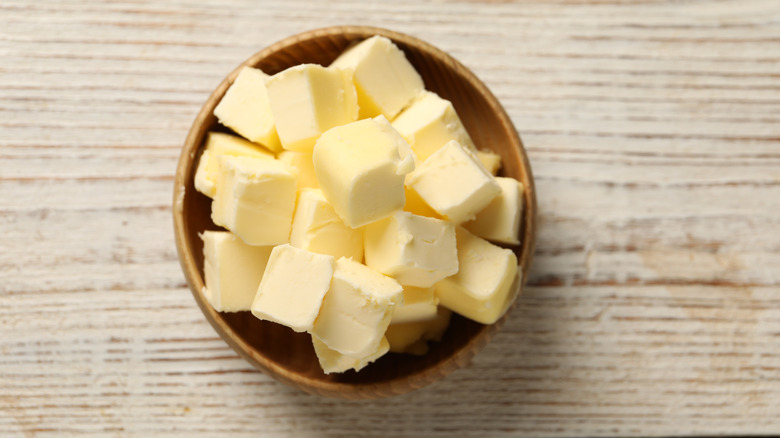5 Essential Butter Sauces You Should Know How To Make
The ability to make a great sauce is undeniably a cornerstone of cooking, no matter what cuisine you're talking about. From Auguste Escoffier's five mother sauces to the decidedly less traditional Alabama white barbecue sauce, or even sweet accompaniments like a fruity concoction of orange and cardamom cranberry sauce, there is seemingly an endless well of mouthwatering sauces to use in your cooking. However, some of the most delicious sauces start with something simple: butter.
Making a great butter sauce isn't particularly difficult: It really is the king of ingredients. Its addition makes almost everything taste better, and it's consistently simple to work with, making the butter-infused sauce accessible to every level of cook. Even so, there are so many sauces that begin with butter that it can be difficult for a home cook to know where to begin without being overwhelmed. To find out a good place to start, Food Republic spoke to chef Rob Bleifer, a former executive chef at Food Network. Somewhat unsurprisingly, we ended up in France -– if anyone knows about butter, it's the French, after all.
Beurre blanc is a versatile option that's easy to make
Of all the many butter sauces out there, one of the most iconic — and most versatile — is the beurre blanc. Its deceptively basic ingredients make up a large part of its charm. Chef Robert Bleifer explained, "Beurre Blanc at its core, is a ridiculously simple sauce: chopped shallots, white wine, vinegar, salt and a good cubed butter such as Challenge Butter. What could be simpler? That is why it is 'foundational,'" according to Bleifer, "as there's so much flavor from so few ingredients and so many possible variations."
A great butter sauce has a smooth, silky mouthfeel. "The key to getting the texture right is [to first make] sure you have reduced the wine far enough and then [really be] careful not to have the heat too high when whisking in the butter," Bleifer said. " Also, to keep the texture right, make sure not to try to keep the sauce hot, but to merely keep it warm." If it gets too hot, you run the risk of everything separating and the sauce breaking.
Beurre blanc is beloved among chefs, in part, because it'll go with pretty much anything: "When it comes to pairing it, my first thought is always with seafood, but it's delightful with chicken or pork." The possibilities don't stop there, though. "For easy variations, think about subbing leeks or even garlic scapes for the shallots or putting an Asian spin on it by adding a little miso."
Why hollandaise is so important to know how to make.
"Hollandaise is a magical emulsion of melted unsalted butter, egg yolks, and lemon juice and is one of the mother sauces of French Cuisine," Robert Bleifer explained. Hollandaise is an important one for chefs to know primarily because of all the daughter sauces that trace their roots to it. "It has numerous classic variations by simply adding one or two key ingredients such as tarragon, [shallots], Dijon, cream, or tomato." Adding those shallots and tarragon, for example, along with a little white wine vinegar, leaves you with a béarnaise sauce, hollandaise's bold, somewhat punchier daughter.
Those additions are also important when it comes to what you do with your hollandaise. "Each addition not only changes the flavor and the name of the sauce, but its ideal uses," said Bleifer: "It is so much more versatile than just a sauce for eggs!"
Though it's, of course, at home in a classic eggs benedict, you could also use it instead of a beurre blanc for topping seafood dishes: "Think about serving it with fish ... crab, or lobster," Bleifer suggested. Despite its relative simplicity, hollandaise can be time consuming and a little fiddly to make, the traditional recipe requiring consistent agitation to properly form that all-important emulsion — but there are tricks: "A great cheat to make this easier to make at home is to utilize a hand blender, instead of the constant whisking."
The nutty, delicious, one ingredient beurre noisette
You've probably heard of beurre noisette before by its English name: brown butter. This miracle ingredient makes for a brilliant sauce in its own right, but it's also a great addition to a whole other range of dishes. Robert Bleifer agreed: "Brown butter is such a heavenly addition to so many dishes," he told us. "Unless I'm too pressed for time, I always brown my butter when making chocolate chip cookies."
Brown butter is unique among butter sauces since it can be used both in savory and sweet dishes, making it a particularly useful tool to have in your arsenal. Lucky, then, that it's also perhaps the easiest to make of all the butter sauces. All you need is a saucepan, some butter, and a little patience.
Start things off over a medium-low heat, and let the butter melt — then keep heating it. "[O]nce the butter goes beyond merely being melted, the milk solids separate from the butter fat," Bleifer explained. It's those milk solids that you want to keep a careful eye on. "As this remains over heat (not too high!), the milk solids will first turn light golden and then brown. You'll know it's done when that butter smells nutty and all of the milk solids have browned." You'll be left with a beautifully fragrant ingredient that can be used as a sauce all on its own or incorporated into pretty much anything.
No pan sauce is complete without a finishing of butter
Beurre monté might be the quintessential butter sauce. The thing is, the technique can be used to make a butter sauce out of pretty much any liquid, or to add a luxurious finish to other sauces — as chef Robert Bleifer explained: "'Monter au beurre' literally means 'to mount with butter,' or more simply, to whisk cubes of chilled butter into a hot sauce." Adding butter won't just improve the texture of your sauce either — it'll round out its flavor. "The main reasons for adding a good cold butter, like Challenge Unsalted Butter, are to counter acidity, to add richness of flavor and mouthfeel, and to add a delightful sheen to a sauce."
Just keep in mind that for this technique to really work, you need to keep your butter close at hand and refrigerated. "To guarantee success, have cold cubes of butter ready to go while your sauce is reducing."
This technique is the cornerstone of the classic pan sauce. "I prefer to make a butter sauce when I plan to deglaze the beautiful browned bits in a pan with some wine, as this adds needed acidity to play against the richness of the butter." Just make sure you don't overheat your sauce: "Be sure to either turn the heat down to low or even remove the pan from the heat when you whisk in the butter." This will help stop it from breaking.
A compound butter is the quickest shortcut to add a boost of flavor to any dish
Though not technically speaking a sauce, compound butter is just as useful (and just as flavorful) as any of the other additions on this list. Compound butter is easy to make and easy to use. It's a great thing to have in your fridge, ready to go at a moment's notice. "A compound butter is the magical combination of softened butter and herbs and/or flavorings that is then typically chilled in the [shape] of a log until it is once again firm," chef Robert Bleifer said. When it comes to choosing those flavorings, the world is your oyster — but herbs and other bright flavors that complement salty, rich butter work nicely. "I love to combine fresh chopped herbs and roasted garlic to deliver an herbal freshness with the nutty complexity of the garlic."
Compound butter is a great option to break out if you don't have the ingredients for another sauce on hand — or if it's a weeknight and you just can't be bothered to make one. "It is so easy for home cooks to be able to simply add a slice of compound butter over a finished piece of fish, chicken, pork chop, burger, or steak to elevate a dish, instead of having to prepare a sauce."
When you're making it, salted butter is the way to go: "I prefer to use salted butter for a compound butter, as there's no fear of there being too much salt, as there's no reduced sauce or deglazed pan." This will ensure the flavors in your compound butter really pop.






